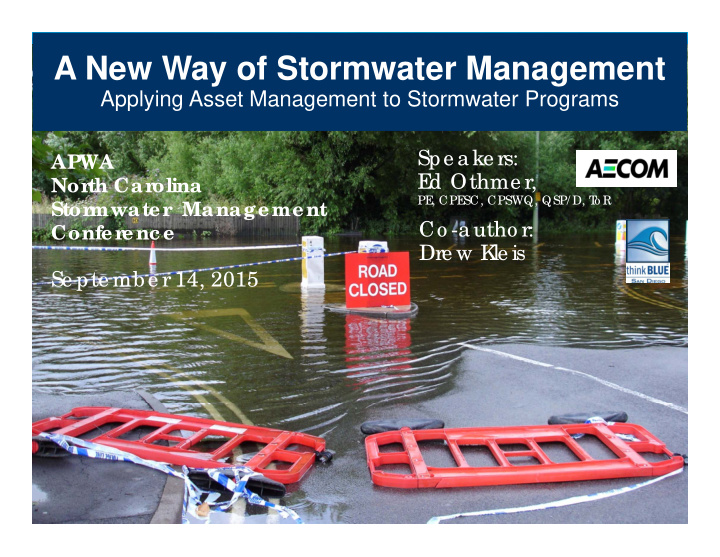



A New Way of Stormwater Management Applying Asset Management to Stormwater Programs Spe ake rs: APWA E d Othme r, Nor th Car olina PE , CPE SC, CPSWQ, QSP/ D, T o R Stor mwater Management Co -autho r: Confer ence Dre w K le is Se pte mbe r 14, 2015
Agenda 1. Emerging Business Conditions 2. Approach 3. Future Investment Needs (Example)
Emerging Business Conditions
Emerging Business Conditions http://www.colbertnation.com/ Source: http://www.colbertnation.com/the ‐ colbert ‐ report ‐ videos/425692/april ‐ 22 ‐ 2013/tiny ‐ triumphs ‐‐‐ infrastructure ‐‐‐ river ‐ pollution
Emerging Business Conditions • Increasingly stringent regulations • Aging infrastructure • Flood planning disconnected from water quality planning • Customer base not aware of all services provided • Changing Boards and Councils • Limited resources • Key employees are retiring • Renewed focus on accountability
Approach
What is Asset Management? • Clearly communicates – What we need & why we need it – Long term funding needs to sustain the services – Consequences & risks • Sound basis for prioritizing work • Transparent, balanced
Risk ‐ Based Planning Represents a New Focus OLD NEW • Budget based on last year Backward Forward • Based on asset risk scores and • Little knowledge of system Looking Looking cost risks • Projects determined as • High risk assets slotted for Reactive problems arise during the Proactive renewal before failure occurs year Risk or • Budget could be determined Budget • Do as many projects as Budget based on agreed risk targets for Constrained you can afford each year system Constrained Ignores Focused on • Money is spent but overall • High risk assets addressed first asset and risk may not have been risk • Budget may rise or fall to meet reduced much management risk targets system risks
What Is Failure? Desired Condition? Minimum Standard?
Levels of Service
Steps 1 – 5 Asset Registry & Levels of Service Step 6: Business Risk Evaluation Steps 7, 8, & 9: Optimize Investments and Fund
Mission, Goals, and Core Principles
Program Integration “Holistic Approach” Storm water as Best Resource Available Science NPDES Flood Risk Mgmt TMDLs Cond. Assessment Watershed Asset Management Plan
Asset Management Overview 1. What do we own / manage? 2. What is its required level of service? 3. Which assets are critical? a. Condition b. Business Risk Exposure 4. What are my optimized management strategies? a. What needs to be done? b. When? c. Costs? 5. What do I need to do to fund it? Identify Determine Determine Set Target Inventory Failure Residual Replacement Levels of Assets Modes Life Costs Service Assign Determine Determine Fund Risk Rating Management Appropriate Build the AMP Your Strategy (Criticality) Strategy CIP
Asset Definition & Hierarchy Right-of-Way
Asset Definition & Hierarchy
What’s More Important? Source: City of Raleigh, Update on Integrated Stormwater Project Prioritization Model
What Is The Risk Associated With My Assets? Business Risk Exposure (BRE) Analysis: • The most powerful element in asset management! • Not all asset are equal! • Used for prioritization of activities with limited funding Triple Bottom Line Condition, Consequences Reliability, Business of Failure Performance Risk Exposure Probability Consequence of Failure (PoF) of Failure (CoF) x PoF CoF = BRE
Triple Bottom Line for CoF • Balanced • Transparent • Recognizes all concerns • Doesn’t borrow from future generations
Business Risk Exposure
Inputs and Outputs Natural Hard Soft Assets Assets Assets Asset Management TMDL Staff Database Compliance Data Water Quality Watershed Asset Improvement Plans Management Plans
Future Investment Needs (Example)
Where’s the money coming from? What’s How am I this gonna going to pay cost me? for this? The Operations Manager The Finance Manager
Long Range Capital Needs by Asset Type Year Asset Name Action Type Action Cost Risk Score 2014 Metal pipes LIN-HAS-78 Replace $340,000 25 2014 Metal pipes LIN-HAS-92 Replace $176,000 25 2014 Asset Type Summary Metal pipes LIN-HAS-114 Replace $49,000 20 $600,000,000 2014 Pump #2 Oak St. PS Rehab $20,000 20 2014 GenSet Vine Rd. PS Replace $80,000 15 … $500,000,000 $400,000,000 $300,000,000 $200,000,000 $100,000,000 $0 2014 2016 2018 2020 2022 2024 2026 2028 2030 2032 2034 2036 2038 2040 2042 2044 2046 2048 2050 2052 2054 2056 2058 2060 2062 2064 2066 2068 2070 2072 2074 2076 2078 2080 2082 2084 2086 2088 2090 2092 2094 2096 2098 2100 2102 2104 2106 2108 2110 2112 Hard Assets (including shared) Soft Assets Natural Assets Average
Long Range Capital Needs by Watershed $10,000 $9,000 $8,000 $7,460 $7,000 Total Investment (Million) $6,000 $5,000 $4,225 $3,701 $4,000 $3,000 $2,603 $2,000 $1,134 $854 Average: $1,000 $199.8 M $ ‐ San Diego Bay San Diego River Mission Bay Penasquitos San Dieguito Tijuana River Hard Assets Soft Assets Natural Assets Average Total
Funding Scenarios $5,000 $4,500 Total Backlog ($ Million) $4,000 $3,500 $3,000 $2,500 $2,000 $1,500 $1,000 $500 $- 2014 2019 2024 2029 2034 2039 2044 2049 2054 2059 2064 2069 2074 2079 2084 2089 2094 2099 Scenario 1 - Full Service Level Attainment Scenario 2 - Current Budget ($34.5M) Scenario 3 - Increase $2 M for 5 years Scenario 4 - Increase $6 M for 5 years Scenario 5 - Increase $8 M for 5 years Scenario 6 - Increase $10 M for 5 years
How to get started… 1. A basic inventory can give enough data to justify investment 2. Asset management should not operate remotely 3. Senior management understanding the concept is critical to success 4. Staff should be involved and included in developing the program and compiling data 5. Software does not need be complex 6. You can manage the program JUST GET STARTED
Q&A Ed Othmer, PE, CPSWQ, CPESC, QSD/P, ToR, QISP ToR AECOM Ed.Othmer@aecom.com www.aecom.com
Recommend
More recommend